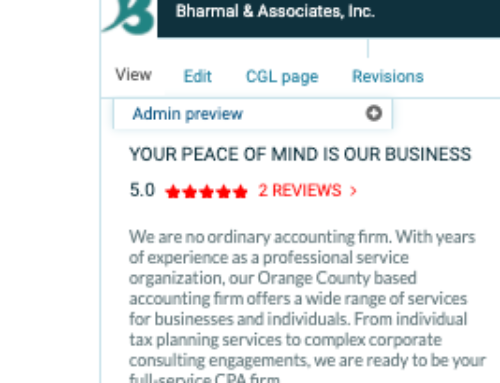As we enter Fall and are rapidly approaching the holiday season, we are aware that the last thing you wish to worry about is tax preparation. However, by taking a little time to prepare for tax season you can avoid any concern or unwanted surprises as you enter into 2016. Pre-holiday tax preparation with allow you to adjust for any life changes and ensure that you’re not withholding too much or too little. It is also important to check your investment performances and gains and losses, which will manage any potential tax hit.
“Paying taxes is the most-significant financial event of most people’s year, so it’s something you should be mindful of throughout the year,” notes Mike Stack, a senior researcher at The Tax Institute at H&R Block. “For instance, many people are surprised by the difference between what they withheld and what they actually owe—whether it’s more or less—when they file their tax return. A midyear checkup can help avoid any surprises.”
To assist you, here is a 7-item pre-tax season checklist.
1. Evaluate life-altering events.
Marriage, divorce, a new baby, or the graduation of a child into becoming a nondependent are all events that will affect the amount that you owe in taxes. You will want to evaluate these events in order to plan accordingly. Other changes that will substantially affect your taxes include changing jobs, taking a second job, or even becoming unemployed.
Events such as retirement or the death of a spouse may necessitate the assistance of a tax professional, but most of these changes can be handled with a simple adjustment in withholding, which leads to #2 on the checklist.
2. Check how much you are withholding from your paycheck.
You should consider whether you are having too much or too little withheld from your paycheck if you received a big tax refund, wrote a sizeable check for tax due with your 2015 return, or experienced any of the life changes discussed above. For example, losing the ability to claim an exemption for a dependent child could increase your tax bill by the amount of the exemption times your marginal tax rate. If you are in the 25% bracket, then you are paying roughly an extra $1,000 in taxes. If you adjust your withholding now, then you may be able to avoid any surprises or deficiencies in April 2016.
There is an IRS withholding calculator that can help you determine how much of an adjustment to make if that adjustment is necessary. Before you begin, ensure that you have your most recent paycheck information available, along with your 2014 tax return. Most taxpayers can make a withholding adjustment on Form W-4 , which you file with your employer.
If you are self-employed or you have substantial investment income, you will want to take a look at your quarterly tax payments. It is particularly important to do so if your self-employment income varies substantially from year to year or from quarter to quarter, or if you have had a large capital gain.
3. Increase your retirement plan contributions.
A simple way that you can reduce the taxes that you pay is to take advantage of opportunities to lower your taxable income by contributing a tax-advantaged retirement account. A taxpayer with a marginal tax rate of 25% could potentially enjoy a tax savings of $250 for every $1,000 of pretax dollars contributed to a 401(k) or 40(b).
The sooner that you increase your contribution rate in your retirement plan or start putting money into an IRA the more time you will have to maximize your tax savings while decreasing the impact on your monthly disposable income.
You can also contribute more this year from the previous year. For 2015, you can increase your total contribution of pretax dollars to your 401(k) or 403 (b) by $500 to $18,000. If you are over the age of 50 you may make a catch-up contribution of up to $6,000; a $1,000 increase from 2014.
If you have not been able to contribute to an IRA in the past due to your income being too high, you will want to check again. The limits have increased and the traditional IRA phase out threshold for taxpayers with a workplace retirement plan is $61,000 of modified adjusted gross income for 2015. Eligibility disappears entirely at $71,000. For couples filing jointly, the new phase out range is $98,000 to $118,000. If you do not have a workplace retirement plan but your spouse does, the new phase out range is $183,000 to $193,000. For Roth IRA’s, the phase out ranges have increased to $116,000 to $131,000 for individuals and to $183,000 to $193,000 for joint filers.
4. Review your investment performance.
If you are an active investor, monitoring your tax exposure should be included in your midyear investment checkup and portfolio rebalancing. If you have investment gains, you can start planning to possibly implement a tax-loss harvesting strategy; timing the sale of certain losing investments to cancel out some of the tax liability from your gains.
But the closer you get to the end of the year, the less time you allow yourself to determine the investments that you may want to sell, and for researching where you might reinvest the cash to keep your portfolio balanced.
5. Plan to maximize your deductions.
Another way to strategize during tax planning for those who usually would itemize their deductions, rather than taking the standard deduction, can be bunching tax deductions in one year to maximize their value. It is important to note that the strategy can be difficult to implement unless you begin to plan for it. Start evaluating the possibilities as soon as possible.
To provide an example, you may consider stepping up your tax-deductible mortgage interest payments during this current year. Another smart move regarding your taxes, if your out-of-pocket medical expenses are high, is to have an elective surgical procedure done before the end of 2015 if you have been considering one. (Elective surgery is only deductible if it meets IRS requirements.) Out-of-pocket medical expenses must exceed 10% of your adjusted gross income before they become deductible, which is 7.5% if you are over the age of 65.
6. Track Your charitable Donations
Many people make donations to charities, but not every keeps a very good record of their contributions, and that can be costly during tax time. Be certain that this year you are diligent about tracking how much you give and where it is going to.
If you do give a significant amount of money to charity each year, you may consider establishing a donor-advised fund, or a DAF. DAF’s will provide you with an automatic record of your charitable contributions, and the opportunity to contribute a lump sum to the fund and take the tax deduction in the current year, while distributing money from the fund over multiple years.
7. Check your health insurance situation.
If you have been putting off dealing with the coverage mandate of the Affordable Care Act, the cost of procrastination is increasing. This year, the penalty due on your 2015 tax return for lack of insurance is $325 per adult or 2% of income above the threshold for having to file a return. (Currently $10,150 for an individual and $20,300 for a family in 2015) That means a couple with income of $120,000 would face a penalty of $1,994.The enrollment period for obtaining coverage through the Health Insurance Marketplace is closed, except for certain circumstances, but you can always purchase insurance on the open market.
Preparing now will save you from panic and uncertainty as you enter the new year and get ready to file your tax return. Your mind will be at ease through the holidays if you are prepared beforehand.
-Ismail and Shoaib Bharmal.




